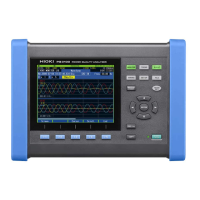Appx.27
Terminology
K factor Shows the power loss caused by the harmonic current in transformers. Also referred to as
the “multiplication factor.”
The K factor (KF) is formulated as shown below:
50
2 2
1
50
2
1
( )
k
k
k
k
k I
KF
I
=
=
×
=
∑
∑
where
k
: Order of harmonics
I
k
: Harmonic current value [A]
Higher-order harmonic currents have a greater inuence on the K factor than lower-order
harmonic currents.
Purpose of measurement:
To measure the K factor in a transformer when subjected to maximum load.
If the measured K factor is larger than the multiplication factor of the transformer used,
the transformer must be replaced with one with a larger K factor, or the load on the
transformer must be reduced.
The replacement transformer should have a K factor one rank higher than the measured K
factor for the transformer being replaced.
LAN LAN is the abbreviation of Local Area Network. The LAN was developed as a network
for transferring data through a computer within a local area, such as an ofce, factory, or
school.
The instrument is equipped with the LAN adapter Ethernet 100BASE-TX. Use a twisted-
pair cable and connect with a star connection to the device generally called the hub (central
computer) of your LAN. The maximum length of the cable that can be used for connecting
the terminal and the hub is 100 m. Communications using TCP/IP as the Ethernet
interface protocol are supported.
Manual event
function
Functionality for generating events when the [MANUAL EVENT] key is pressed and
recording the measured value and event waveform at that time.
In this way, events can be generated as a snapshot of the system being measured.
Use this functionality when you wish to record a waveform but cannot nd an event that
denes the desired phenomenon or when you wish to record data manually to avoid the
generation of too many events.
Measurement
frequency (fnom)
The nominal frequency of the system being measured. Select 50 Hz or 60 Hz.
Multiple-phase
system treatment
Method for dening the start and end of events such as dips, swells, and interruptions in
multiple-phase systems, for example systems with 3 phases
Swell:
A swell begins when the voltage on at least one channel exceeds the threshold and ends
when the voltage readings on all measurement channels falls below the value calculated
by subtracting the hysteresis from the threshold value.
Dip:
A dip begins when the voltage on at least one channel falls below the threshold and ends
when voltage readings on all measurement channels exceeds the value calculated by
adding the hysteresis to the threshold value.
Interruption:
An interruption begins when voltage readings on all channels falls below the threshold
and ends when the voltage on a user-specied channel exceeds or is equal to the value
calculated by adding the hysteresis to the threshold value.
Nominal supply
voltage (Uc)
Typically, the system’s rated voltage Un. When a voltage that differs from the rated voltage
is applied to the contact in accordance with an agreement between the electricity provider
and the customer, that voltage is used as the nominal supply voltage Uc. The nominal
input voltage is dened by IEC61000-4-30.
10
9
8
7
6
5
4
3
2
1
Appx. Ind.

